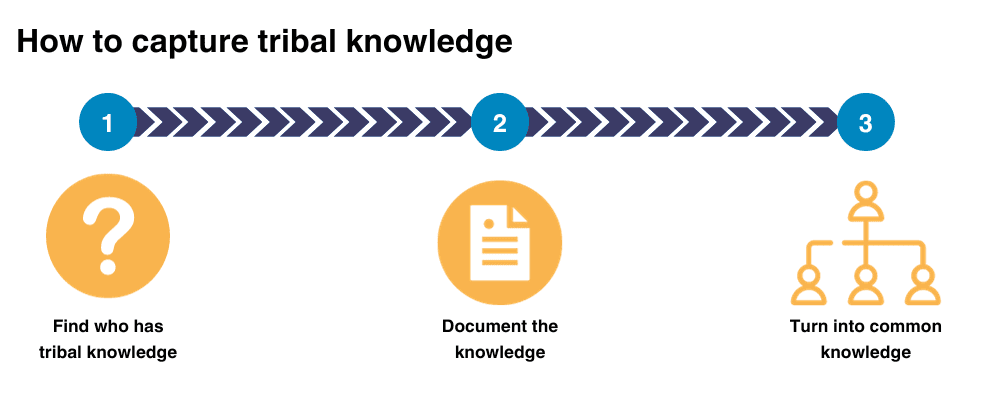What is Tribal Knowledge and How to Capture it
Tribal knowledge is informal, undocumented, and valuable information restricted to only a few people in a workplace. Organizations invest significant resources in documenting their standard operating procedures. Yet, some of them stay limited to only a handful of experienced employees or “tribe.”
Think of tribal knowledge as passing down an old tale from generation to generation. Its portrayal usually changes, but the actual story or information remains the same.
In organizations, tribal knowledge can be trade secrets, account passwords, internal procedures, advantageous relationships, etc. When captured or documented correctly, these pieces of information can be quite beneficial for organizations.
Below, we’ll discuss tribal knowledge and how it can improve productivity, innovation, and teamwork at work.
- Examples of Tribal Knowledge
- Tribal Knowledge vs. Other Company Knowledge
- How Tribal Knowledge Forms / Causes / Drawbacks
- Benefits of Capturing Tribal Knowledge
- Is Tribal Knowledge Bad?
- How To Capture Tribal Knowledge
Examples of Tribal Knowledge
Before we move forward, let’s check out some common types of tribal knowledge in the workplace:
- Account passwords
- Tricks or shortcuts for using pieces of technology
- Internal processes or setups
- Advantageous relationships and connections
- Knowledge learned from the success or failure of previous projects
- Knowing common blockers or enablers of projects
- Some trade secrets
Tribal Knowledge vs. Other Company Knowledge
Tribal knowledge refers to tacit knowledge, legacy knowledge, informal knowledge, and institutional knowledge. It differs from traditional documented organizational information in how it creates and transfers easily.
Generally, an organization groups this information into two types:
Explicit Knowledge
Tangible knowledge, documented as the standard operating procedure (SOP), records, or official reports, constitutes explicit knowledge. All employees share this type of information, crucial for smooth workplace operations, regardless of their knowledge and skills.
Common examples of explicit knowledge are how-to guides, onboarding documentation, and safety protocols.
Implicit Knowledge
Implicit or tacit knowledge is the intangible information subjective to every employee. It’s the informal knowledge shaped by a person’s values and beliefs, which makes it tough to share or discuss.
Personal experiences, skills, stories, and learning are some examples of implicit knowledge. In fact, a large part of the tribal knowledge falls under this group.
How Tribal Knowledge Forms / Causes / Drawbacks
An organization’s specific group of people or “tribe” creates tribal knowledge by retaining implicit knowledge. These individuals are usually the most experienced ones you depend on for mentorship and skill development.
On-the-job training, experience-based learning, and knowledge-sharing sessions form tribal knowledge within an organization.
Yet, tribal knowledge has one significant drawback: it transfers inconsistently and without control. As undocumented information, it spreads across the organization via word of mouth. This means you can’t differentiate right or wrong and if the information will reach all the employees similarly.
Therefore, companies must capture tribal knowledge to ensure its accuracy and availability.
Benefits of Capturing Tribal Knowledge

As we know, documenting tribal knowledge is critical to ensure it remains consistent and effective across the organization. Here are some benefits of capturing this knowledge:
Future Proofing
The biggest advantage of documenting the knowledge is accessing it whenever needed. The information will remain preserved in the future even if an employee leaves. This is helpful in economic crises like the “Great Resignation” when many employees with tribal knowledge leave their company.
Increase Productivity and Innovation
Documenting tribal knowledge promotes a culture of “collective wisdom” where employees have the best knowledge and skills. It ensures everyone is on the same page and following the same SOPs.
This, as a result, improves efficiency and productivity within the workforce, leading the organization toward innovation and growth.
Collaborative Culture
Capturing tribal knowledge also ensures the sharing of common knowledge among team members. When every employee knows and implements the same processes, it promotes collaboration within the workplace.
What does a collaborative culture bring to the organization? More productivity, revenue, and, ultimately, growth!
Is Tribal Knowledge Bad?
Spreading any information without verification, control, and consistency can be detrimental. The same is the case with tribal knowledge. It isn’t actually bad. When communicated and captured correctly, it can lead to continuous learning, improvement, and collaboration.
Tribal knowledge can only be risky if it remains limited to a specific group. If employees don’t know the best practices to solve a problem, the organization will remain stuck with it in the long run. This leads to a substantial waste of resources and time.
Undocumented tribal knowledge can also create skill or knowledge gaps. It limits the critical information or skills to experienced individuals who can retire or resign at any time. This is why it’s essential to capture tribal knowledge.
How To Capture Tribal Knowledge
Businesses must learn to collect tribal knowledge to bridge gaps in knowledge and share crucial information among their staff. Doing so also reduces the downtime and resource waste.
Here is how you can efficiently capture tribal knowledge:
Identify Tribal Knowledge
The first step is identifying the type of tribal knowledge that can help you achieve your organizational goals. If you haven’t determined your goals, do it before identifying the tribal knowledge.
The best way to identify your business’ tribal knowledge is by auditing your assets and existing documentation.
You can do this efficiently with Parsable’s Connected Worker Solutions®. These applications help employees access their business’ critical information, tools, and resources whenever needed. It allows you to identify areas lacking knowledge and areas open for improvement to align with your goals.
After identifying tribal knowledge, determine which employees know helpful information about your products or services. They will help you capture tribal knowledge efficiently.
Capture It In Short, Shareable Courses
The next step is to develop a knowledge management strategy to organize, communicate, and leverage the documented tribal knowledge. It keeps the information readily accessible to everyone.
One way of documenting tribal knowledge is by creating short, shareable courses, playbooks, SOPs, and different training materials. Parsable’s Connected Worker Solutions® can help you here as well.
First, transform your implicit knowledge into paper-based forms or documents. Then, turn them into short digital courses using Connected Worker Solutions®. Training materials populate on in the app, where your employees can easily view and share them whenever they need.
Encourage a Culture of Collaboration
Prioritizing collaboration, learning, and development in a workplace motivates employees to give their best.
By using Parsable’s Connected Worker Solutions®, organizations can facilitate effective, seamless communication and collaboration among their team members. It enables real-time interaction that prompts smooth operations, problem-solving, and decision-making.
Your remote team can join team meetings using video calls and augmented reality, promoting a strong, collaborative culture.
Establish a collaborative work culture by making your tribal knowledge accessible to every employee. Get in touch with Parsble today and pave your way towards better efficiency and productivity!
Ready to revolutionize your operational workflows? Experience the power of Parsable’s Connected Worker® software firsthand. Schedule a demo today and discover how our solution can streamline your operations by digitizing your frontline.







